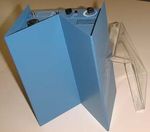V-Detector User's Manual - Northwest Marine Technology, Inc - Northwest Marine Technology Inc., 4003 Airport Road, Anacortes, WA, 98221, USA
←
→
Page content transcription
If your browser does not render page correctly, please read the page content below
Northwest Marine Technology, Inc.
V-Detector User’s Manual
Northwest Marine Technology Inc., 4003 Airport Road, Anacortes, WA, 98221, USA
Phone: +1-360-764-8850; Email: office@nmt.us; www.nmt.us
1 GEV 2021Introduction
The V-Detector is used for hands-free detection of Coded Wire
Tags in fish, fish heads, or other animals. It is light, rugged and
while it is not waterproof, it is adequately protected to tolerate the
usual wet environment.
The V-Detector detects small changes in the magnetic field that are
caused when a tag is moved past the sensors within the V. The
most sensitive areas are outlined in orange in picture to the right.
The V-Detector is shielded on the sides and back to reduce
interference from other sources of magnetism. You can further
reduce false positive signals by selecting suitable locations for tag
detection:
1) The V-Detector is sensitive to movement and will beep if jostled or bumped. To avoid this, position
it on a firm surface. If you prefer, the V-Detector can be mounted on a post or wall using the two
¼” x 20 threaded sockets on the rear panel.
2) Avoid bumping the V-Detector with hands or the specimen.
3) Avoid use near sources of magnetic interference such as motors or generators.
4) Remove watches, jewelry and other metallic items while operating the V-Detector.
Operation
The control panel and its functions are shown below.
Turn the selector knob to the battery check position to verify that the charged battery is installed. If the
tone and light signal, the battery is satisfactory.
1) Select the desired signal, either the tone and light position, or the light only position.
2 GEV Jan 20212) Set the gain control to the highest sensitivity (clockwise) setting which
does not produce excessive false signals. After the gain has been set, pass the
CWT Detection Standard briskly up and down within the V to make sure that
tags can be detected. The gain setting is stable and once adjusted, will need
only occasional trimming.
3) After the gain has been set, position the V-Detector with the control
panel facing down. When the V-Detector must be operated with the control
panel facing up (e.g. when using the light only signal), install the clear
protective cover provided to keep the control panel dry. Try to minimize the
amount of water that gets on the control panel so water will not enter the case.
Tag Orientation
Detection of the tags by the V-Detector depends on the orientation of the tag with respect to the
detector faces. Proper orientation is shown below. Note that the tag position as shown applies equally
to either face of the V-Detector. Proper tag orientation is critical when sampling for half-length tags.
Tips
1. Operate the V-Detector with the control panel facing down or use the clear cover over the
controls to prevent water from accumulating inside the detector.
2. Remove excess water and dry the unit before storing.
3. Do not force long mounting screws into the rear panel mounting sockets. The sockets are
closed to prevent water entry, and are designed to accept slightly more than ¼” of threaded
length ¼” x 20 thread.
4. Remove the batteries for long term storage.
3 GEV Jan 2021Troubleshooting If the V-Detector performs erratically: 1) Replace the battery. 2) Check for sources of outside magnetic interference. 3) Check for water inside the case. If water is found inside the case follow the drying instructions found under “Accidental Immersion” below. Accidental Immersion The V-Detector is not designed to be immersed. However, if properly cared for at the time of the incident you may be able to avoid or minimize the damage by following these steps. 1) Turn off the power. 2) Remove the screws at each end of the control panel. Gently pull the control panel away from the case (there is a cable that prevents complete removal) and drain the water out of the case. Let the unit dry completely before reinstalling the control panel. Note: If the immersion is in salt water, gently rinse the entire detector (inside and out) with fresh water before leaving it to dry. Maintenance To replace the battery: Gently pry the spent battery out of the holder from the end without the contacts. Line up the new battery contacts to slide onto holder contacts. Push down battery using fingers until it snaps into place. Note: Most rechargeable 9-volt batteries are 7.2 volts and will not work well in the V-Detector. Warranty All equipment and parts offered for sale by Northwest Marine Technology are fully guaranteed for one year following the invoice date against failure caused by defective material or workmanship. Within the guarantee period, NMT will repair or replace at its discretion and free of charge, F.O.B. Shaw Island, Washington, all defective parts or defects in workmanship. This does not apply to parts or materials experiencing normal wear and tear; nor does this apply to NMT equipment used with tags or parts that NMT has not tested and approved for use in NMT equipment. NMT is not liable for (i) consequential damages; (ii) incidental damages, or (iii) implied warranties of merchantability or fitness for a particular purpose. No other warranty, express or implied, is made. 4 GEV Jan 2021
You can also read
























































